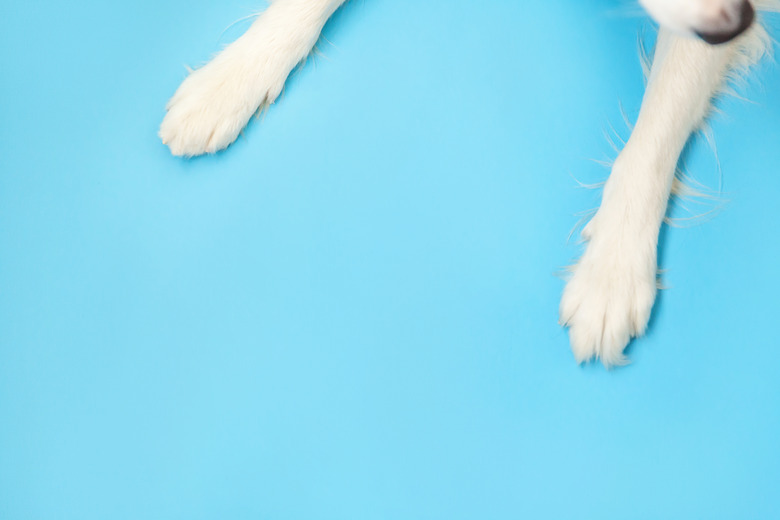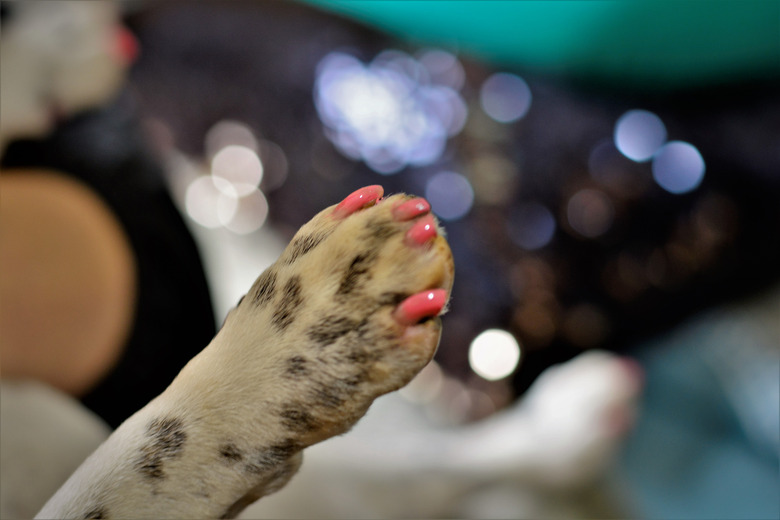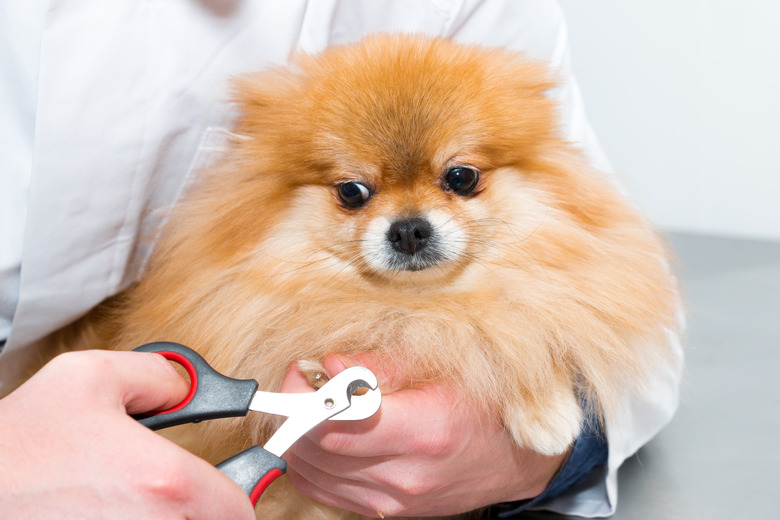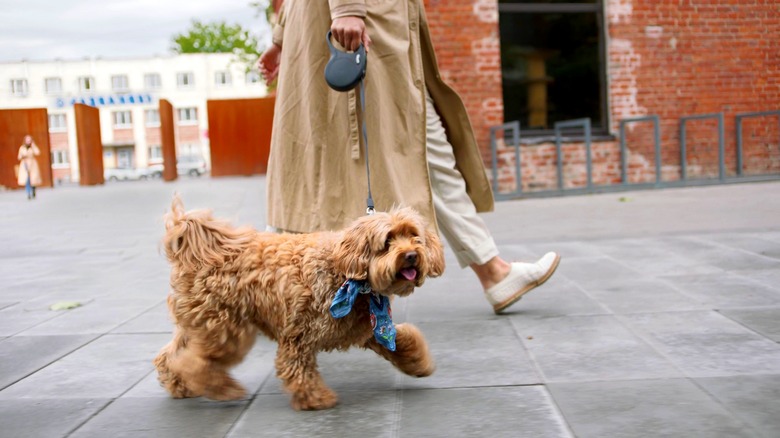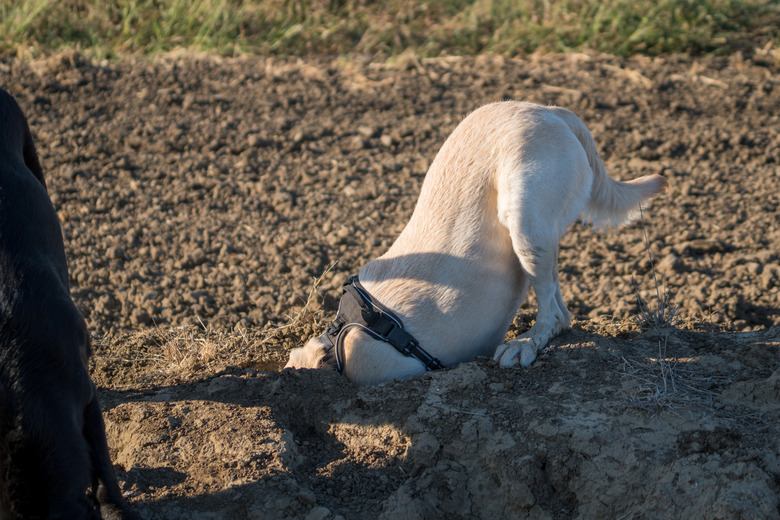11 Fascinating Facts About Dog Claws
Ever wonder why humans have "nails" and dogs have "claws"? Turns out, human nails are just sort of flat, hard pieces of keratin that provide a little bit of protection to our fingertips. But in dogs, their claws are so much more than that. Whether you paint your dog's claws, trim them yourself, or have a groomer do it, dog claws are much more than just nails, as these fascinating facts about dog claws prove!
1. Dog claws do not retract
1. Dog claws do not retract
One of the prime differences in cat claw and dog claw anatomy is that cat claws retract and dog claws do not. If you are in the wild and are tracking an animal and see claw prints, it's a dog and not a cat. Cats have a slight advantage in this area as retractable claws means the claws are more protected and thus stay sharper. If a dog is active outside, they can have very short claws because they often get worn down.
2. A dog's claws are tools
2. A dog's claws are tools
A close-up view of a dog's claws reveals that they are shaped sort of like soccer cleats. One of the purposes of these "cleats" is to give your dog traction as he is running on grass. Some dogs, like terriers and dachshunds, who were originally bred to find small animals in tunnels, love to dig. They wouldn't be nearly as good at digging if it ween't for their claws.
3. You can buy dog nail polish
3. You can buy dog nail polish
If you ever want to have some "me and mini-me" fun with your dog, consider painting your dog's claws the same color that you paint your fingernails. It's not recommended that you use human nail polish for dogs because of some of the harmful ingredients in most nail polish. In fact, research shows that humans using nail polish in general might be a risky business as well.
Questionable chemicals in human nail polish include toluene, formaldehyde and dibutyl phthalate – salon workers wear masks when they are painting nails because of these chemicals. Dog nail polish might cost more, but won't contain these ingredients. If your dog has dark-colored nails, consider painting a base coat of white and then putting the color you want on top of it.
4. Dog claw color can vary
4. Dog claw color can vary
If you do decide to paint your dog's nails, the color you pick might change based on the paw. The color of the claw is determined by the color of the surrounding skin and hair. If your dog has different color paws, you may have noticed that her claw color varies. For instance, it's possible for a dog to have black claws on a brown paw, but the same dog can have a mixture of white and black claws on a paw that is white.
5. Some dogs can have more than four toes
5. Some dogs can have more than four toes
Dogs typically have four functional toes plus a non-functional fifth claw called a dew claw. (More on that later!) There is a breed of dog, the Norwegian Lundehund that is naturally polydactyl, meaning they have extra toes. The Lundehund has at least six toes on each foot that are fully developed and functional. Four point forward, and two point inward.
Fossil evidence indicates that animals that lost toes, like dogs and cats, over their long evolutionary period did so because moving on four toes rather than with flatter feet helped them maintain higher speeds over longer distances.
The evolutionary advantage for the Lundehund of having extra toes gives them better traction over the rocky cliffs of the remote island where they were bred over centuries. These dogs are sometimes called "puffin dogs," because the islanders used them to hunt puffins (a type of bird), and their eggs, which the dogs had to find by scrambling up step and uneven terrain.
6. Activity wears dog claws down
6. Activity wears dog claws down
Because a dog's claws don't retract, they are always out, meaning they are always clicking and clacking across whatever surface your dog is walking across. And like human nails, a dog's nails are always growing.
If your dog primarily walks on grass, they will likely need more trims than a dog who goes for walks on city sidewalks most often. Most dogs do not like having their paws or claws handled, so if your dog does not like nail trims, take them for longer walks on concrete surfaces and you may not have to do a thing.
7. Dog claws can loop if they grow too long
7. Dog claws can loop if they grow too long
If a dog's claws don't get trimmed or naturally worn down, they can grow long enough that they start to curve back in a loop and can impact the foot pad. Even before this happens, the long nail can cause paw pain for your dog, and may cause problems with their walking or balance.
If you're trimming your dog's nails, it's a lot easier if your dog has clear claws rather than black claws. This is because clear claws makes it a lot easier to see the "quick," or the tissue that nails grow from. The quick is rich in nerves and blood vessels, so if you accidentally hit the quick when you're trimming your dog's nails, he will definitely feel it.
The longer a dog's claws grow, the longer the quick grows too. If this has happened, trim the claws a little at a time, about once a week. This might take months if a dog's nails are really long!
8. Dew claws need to be trimmed
8. Dew claws need to be trimmed
Even if your dog is active in running along the sidewalk or street enough that their regular claws get worn down, the dew claw doesn't get worn down because it doesn't touch the ground. Some people have the dew claws removed because they don't seem to serve any purpose. That said, some vets and groomers have reported that they have seen dogs use their dew claws to do things like rub their eyes or hold a toy.
There is a variety of anatomy among dogs and how the dew claws are structured. Some dew claws are held more tightly to the paw and some are more "floppy," with looser skin around them. These floppier ones are the ones that carry a greater risk of getting snagged on something, so keep those dew claws trimmed if that's the case with your dog.
9. Dogs are (usually) either right- or left-pawed
9. Dogs are (usually) either right- or left-pawed
Some dogs show a clear preference for one paw over the other, while a lot of dogs are comfortable leading with either paw. Want to observe your dog's preference? Get a Kong, that hollow rubber toy, and stuff it with food. Compare the number of times she uses her left paw to hold the toy with the number of times she uses her right paw. When researchers do this, they also observe whether the dog uses both paws at the same time. The "Kong test" seems to indicate that there are an equal number of left-pawed dogs, right-pawed dogs, and dogs with no paw preference.
Another way that researchers examine this is with which paw a dog takes his first step from when in a standing position. In this study, more dogs show a right paw preference. Yet another study examining dogs and the way they eat showed that dogs have a preference for what side of his body his food dish was placed. This study showed that half the dogs had no preference, while the other dogs showed a clear preference for either their right side or their left side.
10. Dogs have scent glands on their paws
10. Dogs have scent glands on their paws
When your dog is scratching in the yard or on the carpet when you visit a friend, they're doing more than just sharpening their claws. Dogs have scent glands on their paw pads, and they like to spread their scent, especially after they pee or poop. When you see them scratching the ground after they pee or poop, they're sending a "smell-mail" to other dogs that may come by.
It's likely a form of social communication, and some dogs seem to really enjoy scratching the ground after "going." Some dogs may scratch the ground where they have found another dog's area, or they may start scratching after another dog joins the household in a way to mark their own territory.
11. Your dog's toes can help diagnose disease
11. Your dog's toes can help diagnose disease
Aggressive cancers can appear in the nail bed of a dog's paw. These cells grow and divide rapidly, so they seem to be a magnet for melanomas and squamous cell carcinomas. Although skin melanomas can develop anywhere on the body, tumors in toes represent almost one quarter of melanomas in dogs.
If your dog is excessively licking or chewing a toe, or if a toe seems to be painful and swollen for an unknown cause, it's worth taking her in to the vet to get it checked out.
Always check with your veterinarian before changing your pet's diet, medication, or physical activity routines. This information is not a substitute for a vet's opinion.
References
- Daily Dog Discoveries: How Dogs Use Their Nails
- Dogtime: The Dirt on Dogs Who Dig
- Canidae: Why Do Cats Have Retractable Claws?
- AKC: Norwegian Lundehund
- Daily Dog Discoveries: Why Dogs Have Four Toes
- Live Science: The Hidden Risks in Nail Polish
- Whole Dog Journal: The Importance of Clipping Dogs' Nails
- Bow Wow Insurance: Clipping Dew Claws vs. Keeping Them
- AKC: Is Your Dog Right- or Left-Pawed?
- The Kennel CLub: Long Nails
- VCA Hospitals: Melanomas of the Skin and Toes
- Psychology Today: Ground Scratching by Dogs: Scent, Sight, and Ecstasy
